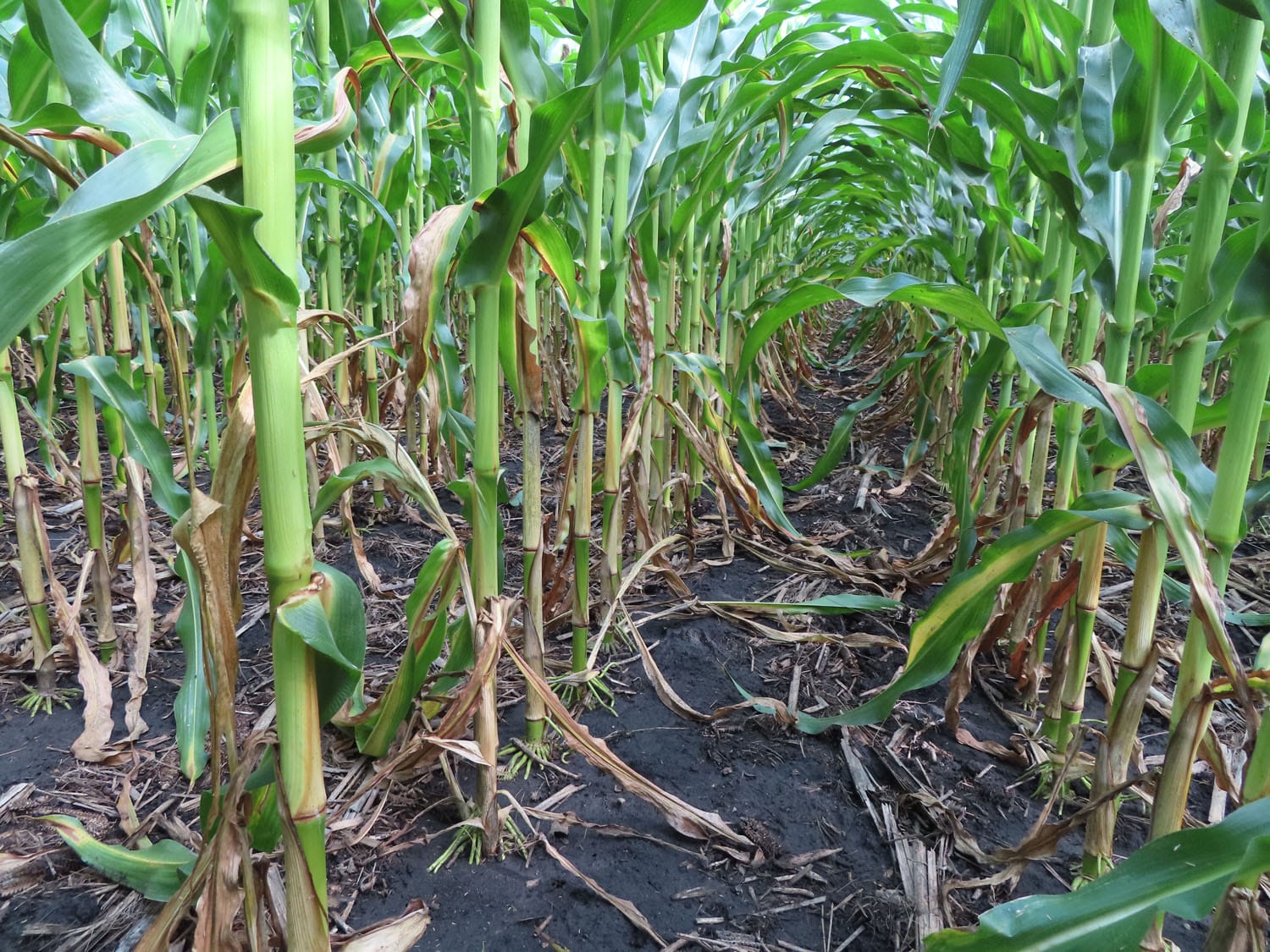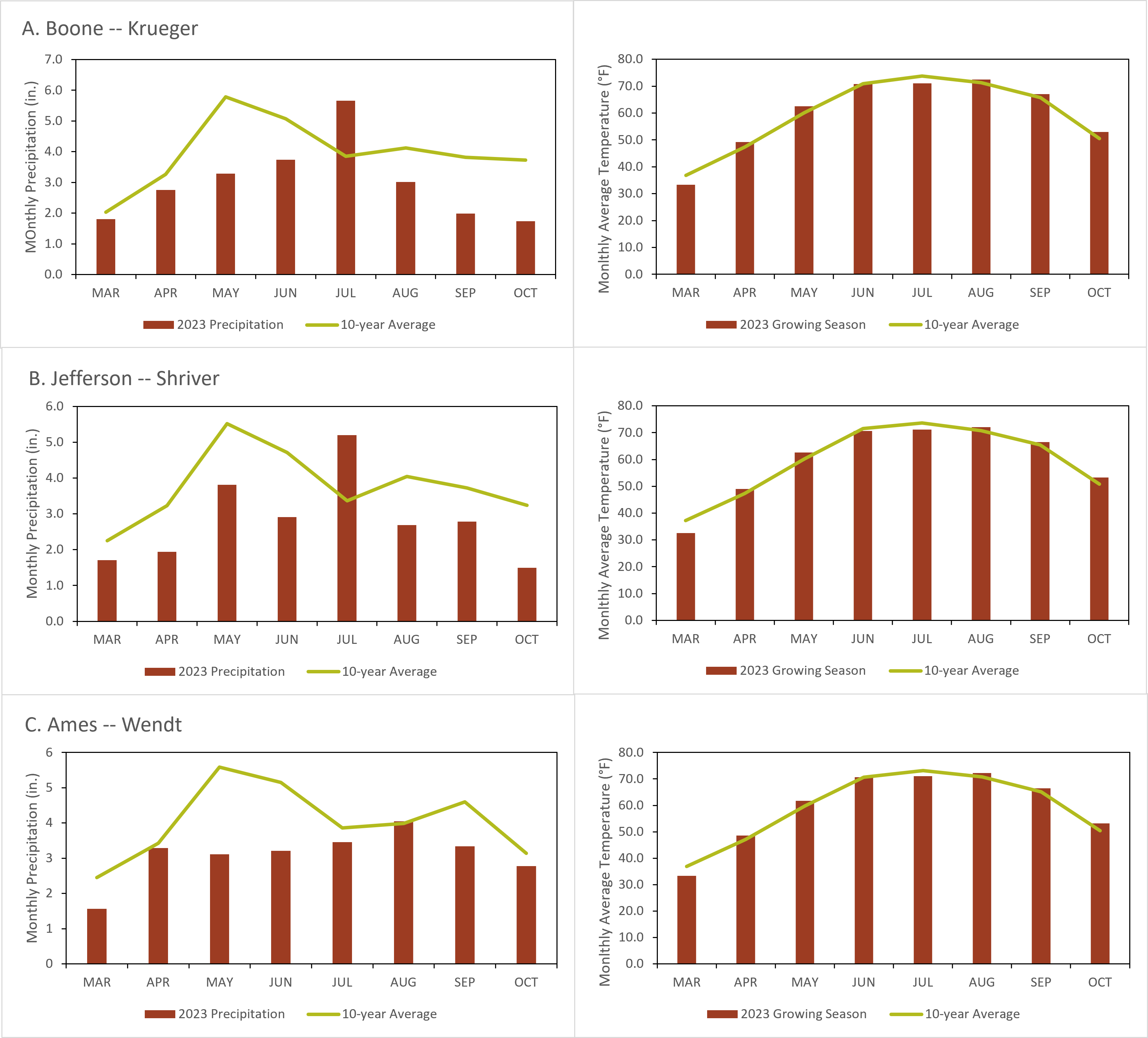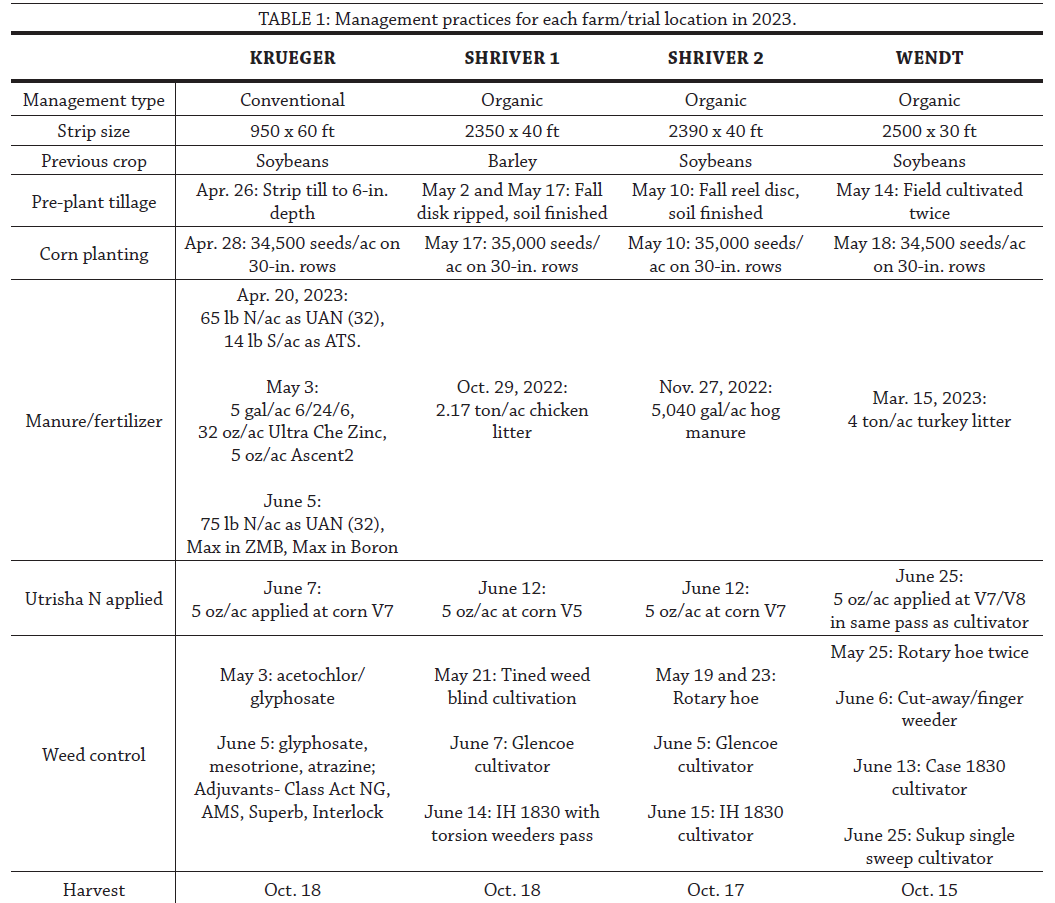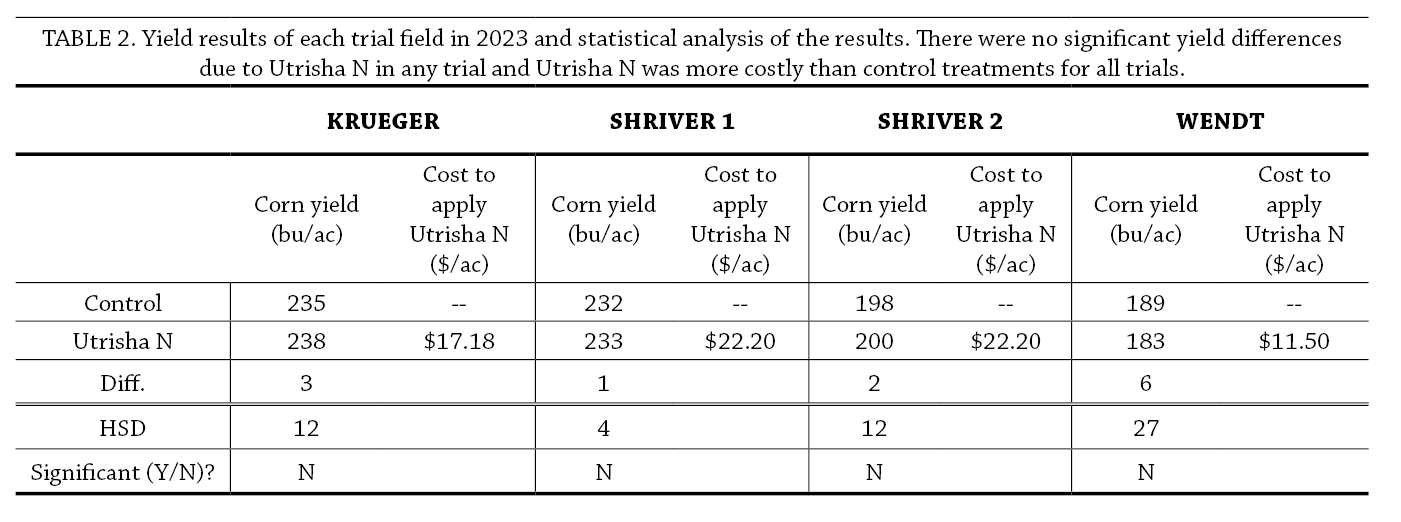This research report was funded by Ceres Trust.
In a Nutshell
- Corteva’s Utrisha N is an organic certified fertilizer amendment product that contains N-fixing bacteria and is marketed as increasing nitrogen supply to crops.
- Three PFI cooperators (two organic, one conventional) performed replicated strip trials testing whether adding Utrisha N to their typical fertilizer program provided any yield benefits.
Key Findings
- Cooperators found no significant corn yield impacts from the use of Utrisha N in three trials in organic fields and one trial in a conventionally managed field.
- Cooperators found that applying this product was a bit challenging and costly due to the need to apply it in a separate pass from other management operations.
Background
Soils and the environment naturally contain a variety of bacteria which fix nitrogen from the atmosphere. In recent years, a variety of agricultural products containing N-fixing bacteria and marketed as supplements to N fertilizers have come on the market.
The idea is that the bacteria in these products colonize soil, crop roots, and/or crop leaves and perform N fixation beyond what the microbes existing in the environment would perform. This extra N fixation could provide more N to a crop, improving yields and allowing for fertilizer application reductions [1].
While manufacturers of these products routinely claim yield increases at a given N fertilization rate with use of their products, independent academic research throughout the North Central US has shown that there are rarely corn or other crop yield responses to a variety of these products [2].
However, most existing independent studies on this topic are in conventionally managed systems, and there is very limited information available on the effectiveness of these products on organically managed systems. Because N is a major limiting nutrient on many organic farms and organic row-crop farmers have limited options for N fertilization strategies, biological N-fixing products could be a useful addition to their fertilizer options if they work [3].
One biological N-fixing product, Corteva’s Utrisha N, is designed to be foliar applied to a wide variety of crops including corn and is certified organic by OMRI. This piqued the interest of several cooperators with organic and conventional operations who wondered if Utrisha N could alleviate N limitation, increase yields and drive financial returns on their farms.

Corn with signs of nitrogen deficiency in Keaton Krueger’s trial. Krueger observed more signs of nutrient stress in plots not treated with Utrisha for several months but ultimately found no significant differences in yield between the two treatments. Photo taken August 8, 2023.
Scott Shriver, an organic producer, noted that “determining if this product can enhance the corn yield without additional nitrogen/manure could have many benefits to our farming operation.” Creating objective and scientifically sound data for themselves and others about these new, novel products was also a major goal.
Tim Graff, an organic producer who was unable to complete the trial due to drought conditions, shared that he hoped the study would “provide objective and quantifiable evidence establishing whether foliar applied N fixing bacteria provide a benefit.” The cooperators designed a replicated strip-trial comparing corn yields under their typical fertilizer rate to yields under their typical rate with an application of Utrisha N.
Methods
Design
To determine the value of Utrisha N, the cooperators compared corn yields under the following treatments:
- Control: Cooperator’s typical practice rate of manure/fertilizer applied.
- Utrisha N: Cooperator’s typical practice rate of manure/fertilizer applied. Utrisha N foliar applied at V4-V8 corn stage.
Cooperators randomly assigned four replications of each treatment in pairs for a total of eight treatment strips. Field management practices for each cooperator/field are detailed in Table 1.
Measurements
Cooperators harvested corn from each strip and recorded yields and percent moisture. Yields were adjusted to 15.5% moisture. Cooperators also kept notes on the cost of management operations relevant to this trial.
Data analysis
We used an analysis of variance (ANOVA) followed by a Tukey’s Honest Significant Difference (HSD) test to determine if there were significant differences in yield between the control and Utrisha N treatments within each trial. We performed these tests at the 95% confidence level, which means that if we find a significant difference, we expect such a difference would occur 95 times out of 100 if the trial were repeated under the same conditions. We could make these statistical calculations because each cooperator’s experimental design involved randomization and replication of the treatments within a field (Figure A1).
Results and Discussion
There were no significant differences in corn yield between control and Utrisha treatments across any of the farms (Table 2). Shriver reflected that “Even though the Utrisha seemed to make no difference, I believe the trial was accurate and therefore gave us usable results.”
The lack of yield impact from Utrisha N echoes previous results from academic research throughout the North Central US which has found no yield increases with use of Utrisha N and other similar products that are commercially available [2]. It also adds to a growing body of work by PFI cooperators showing no yield responses to a variety of biological amendments [4, 5].
Krueger noted that “I was surprised at the visual response in the yield data. Though the results weren’t significant, the Utrisha did have a higher average yield [by 3 bu/ac]” (Table 2).
Corteva details in their Utrisha N factsheet that their on-farm testing of the product resulted in a 6.0 bu/ac yield increase in medium yield land (180-219 bu/ac), and a 3.1 bu/ac yield increase in high yield land (220-280 bu/ac) [6].
This factsheet did not contain experimental designs or statistical methods. All three cooperators generally produce medium-to-high corn yields and perhaps should not have expected large yield increases with use of Utrisha N. Given the expected yield benefits and high costs of purchasing and applying this product, this product may not make sense economically in higher yielding systems even if it does increase yield.
Cooperators on average spent about $17/acre applying Utrisha N (Table 2). Both Shriver and Krueger had to apply the product in a separate field pass which increased the application costs.
Krueger noted that on his operation, “this product has to be applied in a separate pass because it is not compatible with the typical post application products I apply. It also is very sensitive to chlorine so the water that I used to spray it with had to be left in the tank with the lid off for a couple days to use it. These limitations plus the cost make it unlikely for me to actually use it on my current operation.”
Conclusions and Next Steps
Utrisha N applied at V7-V8 stage corn in these four mid-to-high yielding fields did not increase corn yield. The cooperators who trialed Utrisha N this year are not planning to try this particular product again, but some may try other biologicals in the future. Though costly and often tricky to apply, many farmers view these products as worth trialing, especially in organic contexts or contexts where they are hoping to reduce synthetic N inputs. PFI will continue to support cooperators who are interested in trialing biological amendments.
Appendix – Trial Design and Weather Conditions

Figure A1. Example experimental design used by the cooperators. Each Cooperator established four replicates of each treatment assigned in pairs for a total of eight strips.

Figure A2. Weather data from the 2023 growing season and 10-year climate averages at Boone near Ogden, IA (Keaton Krueger); Jefferson, IA (Scott Shriver); and Ames near Huxley, IA (Noah Wendt) [7]. Left graphs show monthly precipitation accumulation in 2023 vs. 10-year normal and right graphs show monthly average temperature in 2023 vs. 10-year normal.
References
[1] L. Reed and B. R. Glick, “The Recent Use of Plant-Growth-Promoting Bacteria to Promote the Growth of Agricultural Food Crops,” Agriculture, vol. 13, no. 5, Art. no. 5, May 2023, doi: 10.3390/agriculture13051089.
[2] D. Franzen and et al., “Performance of Selected Commercially Available Asymbiotic N-fixing Products in the North Central Region,” N. D. State Univ. Ext., vol. SF2080, Apr. 2023, [Online]. Available: https://www.ndsu.edu/fileadmin/snrs/Files/SF2080_Performance_of_Selected_N-fixing_Products.pdf
[3] H. Valenzuela, “Ecological Management of the Nitrogen Cycle in Organic Farms,” Nitrogen, vol. 4, no. 1, Art. no. 1, Mar. 2023, doi: 10.3390/nitrogen4010006.
[4] “Biological Soil Amendments,” Practical Farmers of Iowa. Accessed: Jan. 03, 2024. [Online]. Available: https://practicalfarmers.org/research/biological-soil-amendments/
[5] S. Gailans and J. Boyer, “MycoApply Soil Inoculant for Corn and Soybeans.” Practical Farmers of Iowa, Dec. 04, 2019. Accessed: Jul. 24, 2023. [Online]. Available: https://practicalfarmers.org/research/mycoapply-soil-inoculant-for-corn-and-soybeans/
[6] “Utrisha N Nutrient Efficiency Optimizer Application in Corn.” Corteva Agriscience. Accessed: Jan. 02, 2024. [Online]. Available: https://www.corteva.us/content/dam/dpagco/corteva/na/us/en/files/product-page-resources/utrisha-n/DOC-Utrisha-N-Fact-Sheet-Corn.pdf
[7] Climodat Reports, “Iowa Environmental Mesonet.” Iowa State University. Accessed: Jan. 2, 2023. [Online]. Available: http://mesonet.agron.iastate.edu/climodat/



